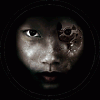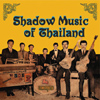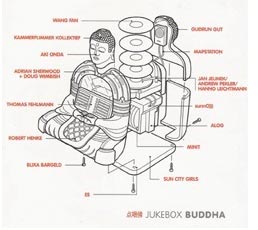- Administrator
- Albums and Singles
 This five disc box set collects all of Tindersticks' soundtracks for the French director Claire Denis. Dating back to their classic second album and continuing right up until their current incarnation, their relationship with Denis has borne exquisite musical fruit that covers a surprising spectrum of styles. This collection is an absolute treasure, covering the two previously released soundtracks with four unreleased works and each one is a masterpiece.
This five disc box set collects all of Tindersticks' soundtracks for the French director Claire Denis. Dating back to their classic second album and continuing right up until their current incarnation, their relationship with Denis has borne exquisite musical fruit that covers a surprising spectrum of styles. This collection is an absolute treasure, covering the two previously released soundtracks with four unreleased works and each one is a masterpiece.
 
Approaching the Nottingham group after a concert promoting their second eponymous album, Denis set the ball rolling on a long-lasting and powerful collaboration. Using the moods and motifs from their 1995 album, they scored her film Nenette et Boni. Beginning with an instrumental version of "My Sister," they set Denis’ work to strings, vibraphone and guitar. The cinematic quality of their music was always evident but here was the proof that Tindersticks were more than capable of adding their voice to another’s vision.
Five years later, the band produced the soundtrack for Denis’ Trouble Every Day (the only one of these movies I have actually seen I must note) where their melancholic but tender music accompanied some very dark subject matter indeed. Blood-drenched, sex-fueled cannibalism is not the first topic that comes to mind when I think of Tindersticks but this is part of the strength of Denis’ film and of their soundtrack. Originating from an unfinished sketch from the Curtains sessions, the score is built around the song "Trouble Every Day" which is perhaps the band’s greatest composition. At live performances around this time (including a concert where they were backed by a 17-piece string ensemble), this song stuck out as being extraordinary even amongst their strong back catalog. Stuart Staples and Dickon Hinchliffe trade vocals across verses as Hinchliffe’s violin and string arrangements create a haunting and desolate drapery for the images on screen. The rest of the band builds a brooding mood throughout; sparse instrumentation punctuated by brass and bass match the threatening eroticism of the movie.
While both these soundtracks have been previously released, the remainder of the box set is dedicated to unreleased works. After Trouble Every Day, Staples and Hinchliffe both scored a film each, L’Intrus and Vendredi Soir respectively. Staples’ "anti-music" for L’Intrus comes as a serious shock to me as he deliberately moves away from everything I would expect from him. Using arrhythmic drum intervals and claustrophobic, gritty guitar, he creates a sound world completely apart from Tindersticks and his own solo recordings.
On the other side of things, Hinchliffe embraces the idea of a traditional soundtrack with both arms. His strings and piano score for Vendredi Soir is a conservative but beautiful work which is in stark contrast to Staples’ racket which precedes it. The final piece, "Sunrise," is particularly gorgeous and it bears more than a passing resemblance to the song "Until the Morning Comes" that Hinchliffe penned for the Tindersticks album Waiting for the Moon. This continuous back and forward between Tindersticks’ main canon and their soundtracks shows just how much of themselves goes into the Denis films; it goes far beyond a traditional composer/director relationship.
Not long after these soundtracks, the group went on hiatus before disintegrating as half of the original members left. Hinchliffe unsurprisingly has moved into composing for film and television full-time and Staples is now leading the second incarnation of Tindersticks. Their studio albums since coming back from the cold have had a different tone compared to the earlier albums and the soundtracks recorded by this new line up are no different. The working relationship between Denis and Tindersticks resumed in 2008 with 35 Rhums. Flute and accordion play prominent roles here, certainly at odds with what I was expecting (a common and happy theme throughout this box). Unfortunately, this disc is rather short but it is absolutely brilliant for its entire length.
The final and most recent soundtrack is 2009’s White Material which throws yet another curve ball; it harks back to the spare arrangements of the earlier soundtracks but explores a completely different atmosphere. If I had been listening to this blind, I would have said it was some other Constellation Records group like Silver Mt. Zion or some of Do Make Say Think’s darker moments. There are times, like on "Andre’s Death," where the group build the tension with scorching guitars and an inescapable rhythm; not descriptions normally associated with Tindersticks but they fit the bill throughout White Material. Even though their main releases have not been too stuck in any particular formula, it is through these soundtracks that Tindersticks have truly experimented with their music.
The five discs are housed in a decadent card box along with a book where Michael Hill writes about Claire Denis and her work with Tindersticks. The essay is published in English and in a French translation and features extensive quotations from most of the artists concerned (though Hinchliffe is notable by his absence). Also included in the book are stunning stills from the various films covered by the box set. While I am never anything less than impressed with Constellation's sleeves and packaging, they have definitely pushed the boat out here.
samples:
 
Read More
- Matthew Jeanes
- Albums and Singles
 Somehow Mick Harris has slipped a couple of records by me in the last few years starting with the Super Mantis Part 1 single released by Combat Recordings in 2008. Scorn somehow makes simple drum beats and atonal bass sound angry. He's been working out this formula for over a decade and has left a traceable line from Super Mantis all the way back to his one-off Weakener project from 1998. In some ways, not much has changed: the bass still warbles and wobbles, the beats are still dead straight and simple, and the ambience is slowed down and impossible to pinpoint. But in other, subtle ways, Harris has refined these tracks over time and he's kept up with and just one step ahead of the legions of younger producers that he has inspired.
Somehow Mick Harris has slipped a couple of records by me in the last few years starting with the Super Mantis Part 1 single released by Combat Recordings in 2008. Scorn somehow makes simple drum beats and atonal bass sound angry. He's been working out this formula for over a decade and has left a traceable line from Super Mantis all the way back to his one-off Weakener project from 1998. In some ways, not much has changed: the bass still warbles and wobbles, the beats are still dead straight and simple, and the ambience is slowed down and impossible to pinpoint. But in other, subtle ways, Harris has refined these tracks over time and he's kept up with and just one step ahead of the legions of younger producers that he has inspired.
The Super Mantis A-Side is heavy and nearly grooveless.Harris approaches the rhythm work with dry precision and the drums are mixed so loudly that they pound and crash without ever really changing.The B-Side is a less-focused remix from Blackmass Plastics that uses Scorn's signature bass grind but ups the tempo in a way that removes some of the original's dread.
Super Mantis Part 1 is followed up by a remix record and another 12" on Combat Recordings, and Scorn has just released another new full length on the US label Ohm Resistance.Clearly I've got some catching up to do.
Read More
- Administrator
- Albums and Singles
 Jefre Cantu-Ledesma is best known for his work in Tarentel and The Alps, but his latest solo release doesn't sound much like either of those bands (no surprise, since they don't sound much like each other either). Instead, his self-described celebration of love itself plunges wholeheartedly into dream pop/shoegazer territory, sounding like Lovesliescrushing's best moments expanded into a warm and enveloping ocean of artfully layered guitar noise.
Jefre Cantu-Ledesma is best known for his work in Tarentel and The Alps, but his latest solo release doesn't sound much like either of those bands (no surprise, since they don't sound much like each other either). Instead, his self-described celebration of love itself plunges wholeheartedly into dream pop/shoegazer territory, sounding like Lovesliescrushing's best moments expanded into a warm and enveloping ocean of artfully layered guitar noise.
It has often been said that the devil gets all the best songs, but a pretty strong case could be made for heartbreak as well.There certainly are some great pieces about love going well, but in general it is the ones about it going wrong that resonate most strongly.Consequently, Jefre's refreshingly uncynical decision to dedicate an entire album to love could have ended very badly for him.Instead, Love is a Stream turned out be an ecstatic, immersive, and thoroughly beguiling work and a rather ingenious detournement as well: Cantu-Ledesma has re-purposed My Bloody Valentine-style blurred guitars by stripping away all the mopery and all elements of traditional rock song structure.What remains is the swooning and hazy distilled essence of dream pop with all the sharp edges and crackle left intact.This is the sort of album that can be very effectively summarized in just one simple line: "45 minutes of excellent blissed-out, shimmering guitar noise."There are some synthesizers and some guest contributors involved—like Xela—but aside from the occasional buried angelic vocals of Lisa McGee, everything else is tangential to Jefre’s gently roiling and hissing cascade of sound.
The album does have some flaws, but they are with structure and sequencing rather than content. I don't understand why Cantu-Ledesma split this album into 12 separate pieces of varying lengths or why he did any tampering with his formula at all.As soon as the absolutely heavenly "Stained Glass Body" ended, my reaction was "What? Why are you stopping?!?"Jefre got everything exactly right with that piece and it could have easily been extended for another 40 minutes to yield an absolutely perfect album.It is not that other songs are disappointments, but some of the textural divergences in other pieces are a bit distracting and it is pretty hard to get sucked into the three songs that only last about a minute–this kind of music demands full absorption.Nevertheless, this is still quite an excellent effort and anyone that has walked into my apartment while it has been on has invariably exclaimed something like "Hey- who's this?I like it."Whoever is playing the role of Cantu-Ledesma's muse appears to be doing a brilliant job thus far.
Samples:
 
Read More
- Administrator
- Albums and Singles

The Dead C's Michael Morley has been releasing solo albums under the Gate moniker since the mid-'90s, but his latest effort is a curve ball that probably no one saw coming: after a decade-long hiatus, Morley has surfaced with an electronic dance album...of sorts. Thankfully, despite ditching his signature gnarled guitars for synthesizers, drum machines, and a laptop, there is no evidence at all that Michael has gone soft. In fact, A Republic of Sadness attains a whole new level of inspiration and subversion, proving that even catchy dance beats can be crushed beneath the weight of Morley's party-killing world-weariness.
I am convinced that Michael Morley must have recently designed a pedal or software application that filters everything he does through malaise or late-night existential anguish (and if he had a "vaguely hostile nihilism" one before, it must have broke).That is the only possible explanation for a song like "Desert," where he is able to make an over-the-top funky synth hook and a propulsive, bouncy beat sound somehow grimy and hopelessly sad.Of course, the fact that there even are hooks at all here is a bit of a startling development, but Morley definitely bends them to his own aesthetic and there is no danger of him ever scoring a hit or enlivening a dancefloor.Each of these six songs can certainly boast something attention-grabbing, like the machine-like percussion of "All" or the awesomely haunting distorted synth motif of "Trees," but Michael inevitably subverts their undeniable immediate appeal by relentlessly looping them into oblivion for the entire duration of each lengthy song.
Longtime fans of Gate may miss the ugly feedback and shambling menace of both The Dead C and Morley's previous solo work, but in most other respects he seems to be the same guy as always, just using some new tools.For example, he still seems pretty hostile towards any kind of conventional song structure or development (though he has made things a bit tighter and punchier than usual this time around).Also, his vocals are still mumbly as hell and sound like they are being dragged out of him against his will.It is a formula that absolutely should not work at all, but for some perverse reason it does.For all his deliberate self-sabotage and willful wrongness, these pieces all achieve a mesmerizing cumulative power and a very appealing nocturnal bleariness.Few artists would ever attempt something as foolhardy as totally casting aside the very things for which they have been known and revered for 20 years (entropy and guitar abuse, in this case), but Morley clearly knew exactly what he was doing.I don't know if A Republic of Sadness is necessarily an improvement over Gate's more snarling, amorphous, and immediately recognizable earlier works like The Dew Line, but Morley's vision was certainly strong enough to survive the stylistic transition relatively intact.At the very least, this is some of the finest late-night listening that I have heard this year.
Samples:
 
Read More
- Administrator
- Albums and Singles
 This self-titled album (not to be confused with their eponymous tape on Hanson from 2007) sees the Ohio trio further refine their cosmic sounds. A huge leap forward from their already impressive releases like Solar Bridge and What Happened, this LP confirms my belief that these guys are creating some of the most important music being made today. There are several moments during this LP that make the hairs on the back of my neck stand up, proving that Emeralds are tapping into something here that is truly extraordinary.
This self-titled album (not to be confused with their eponymous tape on Hanson from 2007) sees the Ohio trio further refine their cosmic sounds. A huge leap forward from their already impressive releases like Solar Bridge and What Happened, this LP confirms my belief that these guys are creating some of the most important music being made today. There are several moments during this LP that make the hairs on the back of my neck stand up, proving that Emeralds are tapping into something here that is truly extraordinary.
There is a danger that Emeralds could just be a formulaic synthesiser band retreading old ground but despite the superficial similarities between their releases, there is something special going on within the music. The three pieces on the first side of this LP leave behind any notion of them being the “bullshit boring drone band” of their debut release; there is way more going on here than the slow soundscapes of earlier releases. “Geode” brings Mark McGuire’s guitar to the front and together the group sounds like something Harmonia would have done if they had started making music for the first time today (but I must point out that this is not simple Krautrock worship). “Diotima” on the other hand takes elements of '90s ambient electronica and experimental rock to create a glacial kaleidoscope of sounds, again McGuire’s precise but irregular guitar arpeggios dancing across the music.
Side B features one long track, “Passing Away,” which distils everything that is great about Emeralds into one dazzling synthesiser jam. John Elliott and Steve Hauschildt’s interlocking synth patterns build up a body of sound which shifts and rearranges itself like a desert in a windstorm. Mark McGuire’s subtle guitar hides amongst the electronic tones, a rare bird occasionally peeking through the mix. The piece dissolves into field recordings of running water and a Buddhist funeral ceremony care of Aaron Dilloway. This juxtaposition of the electronic composition with Dilloway’s documentations of the natural and the divine highlight the ritualistic, psychedelic and organic underpinnings of Emeralds’ music.
Solar Bridge was my album of the year last year but this album puts that one to shame, which is a very bold statement in my book. This is certainly the most impressive thing Emeralds have done yet and given their constant upward trajectory over the last few years, I'm eager to see what the next year brings us.
This release is currently vinyl only so unfortunately no sound samples at this point in time, apologies!
Read More
- Administrator
- Albums and Singles
 Finding themselves a drummer down for their ninth release, Supersilent have this time approached their music from a completely different angle. Dispensing with their usual instrumentation, the remaining members have instead utilized Hammond organ exclusively for these four pieces. While the end result sounds nothing like their previous work, this is a thrilling and captivating album that is an unusual entry into an already curious catalogue. The music is cosmic, sacred and psychedelic in ways that have not previously been delved into by the group.
Finding themselves a drummer down for their ninth release, Supersilent have this time approached their music from a completely different angle. Dispensing with their usual instrumentation, the remaining members have instead utilized Hammond organ exclusively for these four pieces. While the end result sounds nothing like their previous work, this is a thrilling and captivating album that is an unusual entry into an already curious catalogue. The music is cosmic, sacred and psychedelic in ways that have not previously been delved into by the group.
As ever, Supersilent did not plan what they were going to do for this album before entering the studio. The results clearly reflect this approach to music production, the variation in playing style throughout 9 runs from the staid and minimal end of the spectrum to the wilder edge of improvisation. The four pieces here explore limits of the mighty Hammond organ, the music often sounding distinctly unlike the familiar tones of the Hammond. The opening piece begins with a sparse and largely silent introduction before some tremulous melody lines are played. The music slides out of earshot again, an enigmatic and haunting beginning to the album.
The mood here is very different to what would normally be expected of the Supersilent crew, although occasionally they fall into the type of anti-rhythms that permeate their work. For example, the second piece on 9 begins on a similar path as the opening piece of their last album. However, this path has become overgrown and dangerous since we last walked down it; the sinister horror movie character of the Hammond coming through strongly. This is especially true later in the piece when the organ sounds more like some kind of man-eating theremin/guitar hybrid.
The remainder of the album is given over to more ambient-inclined pieces, which is a little disappointing as I would have enjoyed another “busy” piece or two. Listening to these pieces on their own merit as opposed to part of an album (albums being an unnatural environment for Supersilent’s music based on their working method), their true worth becomes evident. The devil is in the detail and devoting one’s attention fully to the textures within the music reveals the luxuriant and multifaceted tone of the Hammond organ.
I wonder whether Supersilent will now continue without Jarle Vespestad on drums, find a replacement drummer or, Darwin forbid, remain super silent. That last option is too horrible to consider but equally I imagine it would be hard to find someone who could fill the void on the drum stool. As good as this album is, I cannot see them repeating it either in terms of instrumentation or in terms of mood. However, hopefully this shake up to the band’s dynamics will spur them on to further experiment with their already fluid sound. And should this be the last we hear from Supersilent, it is a worthy end to a stunning string of releases.
samples:
Read More
- Administrator
- Albums and Singles
 Now reissued on CD after a very limited vinyl-only release in 2008, this fun and absurd compilation of not-quite-surf may very well be the last (and first?) word on the enigmatic Shadow Music scene that very briefly flourished in 1960s Thailand. This feat of DIY ethnomusicology contains some of the most improbable, strange, and obscure pop music that will reach Western ears this year.
Now reissued on CD after a very limited vinyl-only release in 2008, this fun and absurd compilation of not-quite-surf may very well be the last (and first?) word on the enigmatic Shadow Music scene that very briefly flourished in 1960s Thailand. This feat of DIY ethnomusicology contains some of the most improbable, strange, and obscure pop music that will reach Western ears this year.
Shadow Music (also known as Wong Shadow or Thai String Music) has rather unique origins: both its name and (ostensibly) its content were directly borrowed from The Shadows. This confounded me initially, as I had never thought of The Shadows as being particularly influential (compared to, say, The Ventures). However, I have since learned that they were incredibly popular everywhere but the US and that frontman Cliff Richard was essentially the British Elvis Presley (although relatively hip Americans will probably only remember The Shadows for the surf classic “Apache”). Of course, this would not be a very interesting compilation if that influence had been slavish and undiluted and it definitely wasn’t. Instead, traditional Thai melodies were filtered through that instrumental rock influence to create “Thai Modernized Music,” which also absorbed pretty much every other popular foreign musical style that found its way into the country.
Equally strange is that the bulk of the recordings included on this compilation originate from just one man: singer/svengali Payong Mukda, who is responsible for assembling and managing three of the five artists covered (the ridiculous and egotistically named P.M. Pocket Music, The Son of P.M., and P.M. 7). Of the three, The Son of P.M. was the most prolific and probably the best, as their “Cho Cho Chan” and “Lum Jow Praya” stand out as two of the album’s highlights. P.M. 7 and Jupiter’s Latin-tinged “Sawan Bangkok” is equally cool and memorable though.
The album’s opener (The Son of P.M.’s “Luk Tung Klong Yao”) is an extremely representative snapshot of the oddness to come and basically tells listeners all they need to know about to expect from the album. The opening bars feature a simple rockabilly guitar motif that quickly and unexpectedly gives way to something that sounds like a high school marching band. That, however, is itself quickly derailed by a cool psych-rock influenced organ melody that occasionally disappears only to be picked up again by a chorus of women or children. The transitions are not clumsy, but they are disorienting and incorporate several seemingly disparate elements. Throughout it all, heavy Thai percussion and a propulsive, sultry bass line expertly hold the genre-gobbling free-for-all together. The musicianship, enthusiasm, and ambitious arrangements are consistently impressive all over the album, making this deranged stylistic grab bag succeed despite the seeming impossibility and wrongness inherent in the whole genre.
Sublime Frequencies’ resident crate-digger Mark Gergis clearly had his work cut out for himself with this one, as his minimal liner notes show that most information about the artists and their peers has vanished into the swirling mists of history. For example, virtually nothing is known about Jupiter, who appear on roughly a quarter of the album’s songs, and very few of the genre’s artists ever even made it into a recording studio. Consequently, I’m fairly certain that there are a lot of other great Shadow Music tracks out there in the world somewhere, but I am equally sure that no one else will ever find them.
Samples:
- The Son of P.M.- Lum Jow Praya
- The Son of P.M.- Cho Cho Chan
- P.M.7/Jupiter- Sawan Bangkok
Read More
- Administrator
- Albums and Singles
 America's knowledge of African culture is quite minimal, but the tireless work of Alan Bishop and his Sublime Frequencies label has helped us come to a better understanding of some of the music and many folk rituals found across the greater African continent. The latest from Niger import Group Bombino provides another mind-altering picture of musical idioms from an ocean and a lifetime away.
America's knowledge of African culture is quite minimal, but the tireless work of Alan Bishop and his Sublime Frequencies label has helped us come to a better understanding of some of the music and many folk rituals found across the greater African continent. The latest from Niger import Group Bombino provides another mind-altering picture of musical idioms from an ocean and a lifetime away.Guitars from Agadez Volume 2 serves not only as a passport to exotic African ports of call but as an empowering recording. Brimming with a spirit often neglected in America’s cogs and gears, Group Bombino unleash protest after protest in vibrant song. Akin to the folk explosion that occurred during the '60s, Group Bombino are keeping their own folk traditions alive in the face of injustice—and though the plight of Agadez is far more sinister than the less than civilized clashes between flower power and '50s conservatism, it is an energy that any listener with the slightest amount of soul can relate to with each listen.
Group Bombino perform two distinct styles throughout the course of Guitars from Agadez Vol. 2.The first half of the album is ‘dry,’ a bucolic style reliant on flesh-created percussion and acoustic guitar. It is the sound of defiant buskers singing of poverty, neglect, and their second-class status. The melodies aren’t far removed from the ragas and psychedelic finger pickings of modern Western folk but the tone is far more exultant and less understated. The idea of music as celebration is explored and that it is done so without any other pretense beyond making music for the masses of Agadez, the results are triumphant.
The energy is dialed up as Guitars from Agadez transitions from acoustic roots into the frenzied electric stylings associated with Taureg. The atmosphere is still thick with oppression and defiance but the happy mood of celebration continues to infect each jangly strum. Just as a generation of hippies protested the shackles of commonality in the face of Vietnam, the music of Group Bombino and his village do so to their Nigerian governmental objectors. This is the beauty of Guitars from Agadez—we are witness to a movement, not only of body but that of mind and soul. We may stand aghast at the idea of a people trapped by landmines and fear but we can also relate to the idea of celebrating community and the resources and family you do have.
The work of Sublime Frequencies does more than we may ever know to educate a generation of adventurous music lovers about the trials of African life, and though we may never fully comprehend the ups and downs of the motherland, we can appreciate its majesty in the songs of its indigenous people. Group Bombino takes pride in maintaining Agadez’s rich music heritage and the sacrifices they make only fuel the soul of Guitars from Agadez. We’re a society spoon-fed on technological spoils and slick corporate creations but Ghoumour Oumara Moctar Bombino and his ragtag crew is untouched by what we take for granted and emboldened by what they do not.
samples:
Read More
- Administrator
- Albums and Singles

Release Date: 29 August 2011
Mute announce the release of a box set of music and film, comprising the original Johnny Yesno film, a new re-imagining of the film alongside 140 minutes of bonus material and 2 CDs including new mixes by Richard H. Kirk plus exclusive tracks.
Peter Care’s controversial short film, ‘Johnny YesNo’, was made in 1979. Its original soundtrack, recorded and produced by Cabaret Voltaire, was released as an album two years later.
Cabaret Voltaire, alongside Human League, Throbbing Gristle, Fad Gadget and The Normal, were at the forefront of the UK Electronic Movement of the late '70s and were, without a doubt, one of the most influential acts of the last thirty years. Way ahead of their time, Cabaret Voltaire were prolific with blending dance music, techno, dub, house and experimental.
Peter Care is mainly known for his directing effort in music videos where he created several groundbreaking works. One of them, Sensoria, became the most successful "underground" video of all time. He worked with REM, Bruce Springsteen, Depeche Mode and Tina Turner, amongst others. More recently, in 2005, Care received a Lifetime Achievement Award for his music videos and directed episodes of the HBO Series, Six Feet Under.
Disc 1
|
Disc 2
|
Disc 3 - DVD
|
Disc 4 - DVD
|
Read More
- Administrator
- Albums and Singles
 The first compilation devoted to pieces made with the FM3 Buddha Machine includes 15 efforts by artists such as Blixa Bargeld, SunnO))), Kammerflimmer Kollektief, Adrian Sherwood + Doug Wimbish, Es, and Sun City Girls. Overall it achieves a collective consistency which may transcend what Derek Bailey called "lounge electronics, mumbling electronics."
The first compilation devoted to pieces made with the FM3 Buddha Machine includes 15 efforts by artists such as Blixa Bargeld, SunnO))), Kammerflimmer Kollektief, Adrian Sherwood + Doug Wimbish, Es, and Sun City Girls. Overall it achieves a collective consistency which may transcend what Derek Bailey called "lounge electronics, mumbling electronics."
I'm possibly one of the last brainwashed readers to learn that the two members of FM3 created the Buddha Machine, a plastic, battery-operated device resembling a pack of cigarettes or a cheap AM radio, containing nine different brief ambient snippets that loop endlessly. Whether their original idea was to subvert, mimic, or pay homage to chanting devices that have long been sold in temple gift shops all over China, is unclear and unimportant. Not surprisingly, Brian Eno wet his pants over the device, though to be fair his interest in endlessly self-mutating music is well documented and I mustn't let the fact that I don't yet have one color my comments. Some people buy several and play them simutaneously for the interplay, and it's said that a single device sounds different depending upon location. As with The Caretaker's recent meeting demand by supplying a six-disc set that was available for free download, and his gorgeous blue vinyl edition of Stairway To The Stars, here is further proof of the enduring seductive lure of a physical element in music packaging. The Buddha Machine may resemble the fetishistic magnetism of the i-pod, but in seeking to add nothing to itself, it is the opposite of that ubiquitous mini-library.
This record is the first commercially available attempt at compiling music derived specifically from those original nine loops. There might be a bit too much going on here for this album to be used as a tool for actual meditation, but generally the inactive listener isn’t distracted by much. Alog’s "A Dragon Lies Listening" where cooing gives way to nuances of Mongolian throat singing and choppiness, gets a bit worked up, but it could hardly be described as a barrage of glitch. Likewise, Jan Jelinek, Andrew Pekler and Hanno Leichtmann’s "BuddhaMachineCommercial" could sound like crass intrusion into the calm flow, but their welcome cheekiness recalls both the brilliant spoof ads of Sudden Sway and the unintentional humor of the recent Radio Thailand. The running order is good, especially when the slightly unholy and naturalistic twitter of "Little Yellow" by Blixa Bargeld is complimented by the splendid ethereal hum and quake of Es' contribution which follows.
SunnO))) provide "BP/Simple," an evolving 10 minute piece balancing beauty and restraint that whizzes by like an actual two minute 30 second jukebox hit. Minit also opt for less as more. In places, there are echoes of the work of Die Trip Computer Die and Tarwater, both of whom would have been interesting contributors. Elsewhere, on "Karma-Cola," Adrian Sherwood + Doug Wimbush perhaps predictably take the sound to bass depths which no one else approaches, while Thomas Fehlmann focuses on layering vocals pretty much unadorned.
Jukebox Buddha is a bright yet unflashy record worth returning to, and nicely rounded off by Sun City Girls' piece - the closest approximation of an Aboriginal gamelan mutation that I can recall. Unfortunately, now I believe the only way to cleanse myself of the impure desire to get eight of the original machines, each one a different color, turn them on, run a hot bath...is... to consumate that desire.
samples:
- Alog - A Dragon Lies Listening
- Jan Jelinek/Andrew Pekler/Hanno Leichtmann - BuddhaMachineCommercial
- SunnO))) - BP/Simple
Read More
- Administrator
- Albums and Singles
 As much as I was impressed with their last album, it was still a bit patchy. On their latest album, This is Fire is a leaner and more concentrated effort compared to their previous releases. The ladies of Spires that in the Sunset Rise have refined their sound and recorded a wonderful little album. This is the best release from Spires in the Sunset Rise yet.
As much as I was impressed with their last album, it was still a bit patchy. On their latest album, This is Fire is a leaner and more concentrated effort compared to their previous releases. The ladies of Spires that in the Sunset Rise have refined their sound and recorded a wonderful little album. This is the best release from Spires in the Sunset Rise yet.
Secret Eye
Spires that in the Sunset Rise are an acquired taste, the first time I listened to them I found it hard to get by the singing which sounded flat and the formless song structures but the more I listened to them, the more I could appreciate their music. Despite being used to them at this stage, This is Fire was still hard to get into at first. After a few listens it fell into place. Songs like “Clouds” and “Sea Shanty” are quite loose and chaotic in their arrangement, especially on the former with the violin refrain sounding like someone who has never seen the instrument before, let alone played it. The latter has a strong drumming rhythm as a base but the different elements seem to attack the rhythm as opposed to play with it. It is challenging to enjoy them but once I made the effort I was captivated.
The songs combine a dizzying array of traditional music influences. The different singers use different styles, one of them singing the verses in a European folk style with the others providing harmonies with a more Middle Eastern flavour. The percussion combines Middle Eastern and African traditions, particularly the use of instruments like the mbira. There is always a danger of westerners trying to assimilate other musical traditions and diluting them but Spires in the Sunset Rise have kept the integrity, if not the actual form, of the different influences intact.
This is Fire is fantastic and is a big step forward for the band. There isn’t a chink in their armor at all here. The music is constantly powerful and primal, not only that but the band are quite on their own in terms of style. As unique as I find them, it’s only now that I think they’ve captured the perfect sound that they’ve been striving for.
samples:
Read More


